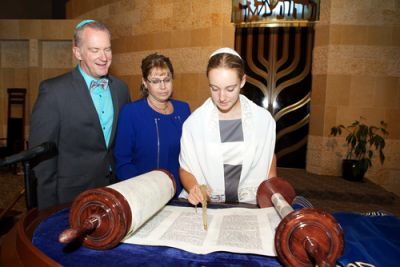 Coming-of-age rites are common around the world. These rituals take on specific meanings within each culture or religion, but most signal that a young person has left childhood behind to become an adult. While some cultures demand physical or mental endurance, others allow their youth to demonstrate knowledge and wisdom. Observed since the Middle Ages, b’nai mitzvah ceremonies hold special meaning for young Jewish people.
Coming-of-age rites are common around the world. These rituals take on specific meanings within each culture or religion, but most signal that a young person has left childhood behind to become an adult. While some cultures demand physical or mental endurance, others allow their youth to demonstrate knowledge and wisdom. Observed since the Middle Ages, b’nai mitzvah ceremonies hold special meaning for young Jewish people.
The History of Bar Mitzvah
You’ve probably heard about bar mitzvah for a boy or bat mitzvah for a girl, but b’nai mitzvah is a commonly used plural form. My Jewish Learning explains that the concept didn’t exist until the Middle Ages. The original age of majority for ancient Israelite men was 20 but lowered to 13 when Talmudic writings were composed and compiled. Male youth could optionally participate in religious life, but no official ceremony determined when this was obligatory.
Over the centuries, religious responsibilities increased for older youth and lessened for young boys. When a boy reached age 13, he was called bar mitzvah, or “son of commandments.” Shortly before his birthday, he could begin wearing small black cubes containing Torah verses known as tefillin or phylacteries. Once his bar mitzvah ceremony took place, he was also allowed to read Torah passages in the synagogue, and depending on his readiness and community’s standards, could recite prayers in front of the congregation. Bar mitzvah signaled to a community that a young boy had assumed the religious rights and responsibilities of a Jewish adult.
Girls and Bat Mitzvah
In some Jewish communities during the Middle Ages, girls and women could also be called to read the Torah. Coming of age for Jewish girls became the bat mitzvah rites, and Rabbi Arthur O. Waskow mentions one of the first American bat mitzvah ceremonies celebrated in 1922. Similar to the original “bar mitzvah” term, “bat mitzvah” translates as “daughter of commandments.” Eventually, bat mitzvah customs spread to other American Jewish synagogues. A girl is considered bat mitzvah when she reaches age 12.
Celebratory Customs in Modern Times
Chabad stresses that b’nai mitzvah are attained the prescribed ages, regardless of whether public rites are held. Yet most families ensure that they celebrate these joyful milestones. During b’nai mitzvah, celebrants receive an “aliyah,” or invitation to go up to the platform and recite a blessing over the Torah. According to ReformJudaism.org, the celebrant may also read from the Torah and possibly the haftarah, a collection of passages from prophetic books of the Hebrew Tanakh. In some synagogues, the celebrant may deliver a sermon and conduct the entire service. Boys put on tefillin, but this practice is becoming more widespread for girls among progressive communities.
B’nai mitzvah celebrations include receptions held after synagogue services. Celebrants who didn’t deliver sermons during services may give them at their receptions. Speeches usually focus on points from the weekly Torah reading and how these apply in the celebrants’ lives.
Gender-Inclusive B’nai Mitzvah
As cultural understanding of gender grows beyond the male-female binary, Jewish communities have kept pace. Besides its usage as a plural form, “b’nai mitzvah” can also be applied to non-binary, genderqueer, or agender Jewish youth. New York Times writer Alyson Krueger adds that some synagogues call them “b mitzvahs” or “they mitzvahs.”
One sticking point youth encounter before b’nai mitzvah celebrations is the heavily gendered nature of the Hebrew language. Fortunately, synagogues are adapting by using English-only texts. To meet the needs of Jewish people outside the gender binary, the Nonbinary Hebrew Project is also building a gender-neutral Hebrew grammatical system.
A Lifetime of Growth
Coming of age brings with it new rights and responsibilities, but it also presents learning opportunities. Growing in knowledge is a central point of b’nai mitzvah. True to life itself, b’nai mitzvah aren’t just one-time events but part of a journey full of discovery.
Add Your Comment